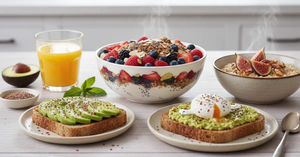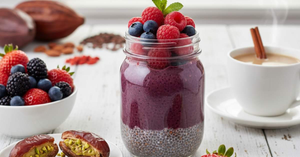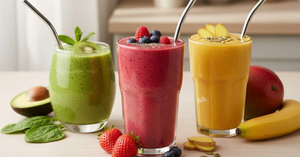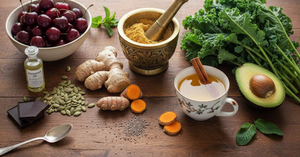“Your cravings don’t make you weak but they’re messages from your body asking for balance.”
Many women experience an intense craving for salty or crunchy foods at certain times of the menstrual cycle, especially during the luteal phase, the week or two before menstruation. These cravings are not random; they are a direct reflection of hormonal shifts, electrolyte needs, and mood regulation.
During the luteal phase, progesterone levels rise, and estrogen declines, which can lead to water retention, bloating, and dips in serotonin. The body may crave salty foods as a way to rebalance fluids or to gain a quick dopamine boost, which helps temporarily elevate mood.
Moreover, cravings intensify when sleep is poor, hydration is low, or meals lack essential nutrients like magnesium and complex carbohydrates. Recognizing these triggers allows you to respond with nourishment rather than guilt.
While salt is essential for nerve function and hydration, processed salty snacks, like chips, fries, or instant noodles, come with added fats, preservatives, and refined carbs. These foods:
The goal isn’t to eliminate salt completely but to replace refined snacks with wholesome, balanced options that satisfy cravings and nourish the body.
Let’s break down what happens biologically:
Understanding this mechanism means you can prevent cravings before they peak by focusing on hydration, minerals, and balanced meals.
Here are science-backed, easy-to-make alternatives that can calm your salty cravings while nourishing your hormones and gut health.
A crunchy, high-protein snack that satisfies like chips without the unhealthy fats.
Why it works: The fiber slows digestion, preventing rapid insulin spikes, while magnesium reduces PMS-related mood swings.
Swap potato chips with baked beetroot, sweet potato, or zucchini chips.
Why it works: These veggies are rich in potassium, which helps counter sodium-induced bloating.
Air-popped popcorn is a light, whole-grain snack that feels indulgent.
Why it works: The crunch satisfies texture cravings, while the fiber helps stabilize blood sugar.
A handful of almonds, walnuts, sunflower, or pumpkin seeds roasted lightly with Himalayan salt can do wonders.
Why it works: Magnesium and omega-3s help modulate cortisol, reducing stress-related cravings.
If you crave something savory and creamy, this is a balanced option.
Why it works: Healthy fats satisfy satiety hormones (leptin and ghrelin), while protein curbs binge impulses.
Steamed edamame sprinkled with sea salt and sesame oil is both nourishing and satiating.
Why it works: Edamame’s amino acids promote neurotransmitter production for mood stability.
When you crave something salty yet light, this probiotic-rich option works beautifully.
Why it works: The probiotics balance gut bacteria, which influence both estrogen metabolism and mood regulation.
A blend of sweet and salty that curbs multiple cravings at once.
Why it works: The natural sugars replenish glycogen while healthy fats prevent sugar crashes.
Beyond snack swaps, supporting your hormonal rhythm through daily nutrition helps prevent intense cravings.
Eat meals with complex carbs, protein, and healthy fats to keep glucose stable. This reduces cortisol and prevents craving triggers.
Drink 2.5–3 liters of water daily. Add electrolyte-rich fluids like coconut water, lemon water, or infused water with mint and cucumber.
Sleep deprivation raises ghrelin (hunger hormone) and reduces leptin (satiety hormone), making cravings harder to resist.
Include deep breathing, journaling, or mindful walks. Elevated cortisol is one of the strongest drivers of salty cravings.
Dark chocolate (in moderation), spinach, banana, and pumpkin seeds help relax muscles and stabilize mood.
Cravings fluctuate naturally across your cycle:
Tracking your cravings alongside your cycle helps you understand patterns and plan balanced snacks ahead of time, a key principle of cycle awareness.
If you notice persistent binge eating, emotional eating, or compulsive cravings that affect your well-being, it’s important to consult a nutritionist, gynecologist, or therapist. These patterns may be linked to underlying issues such as hormonal imbalances, thyroid dysfunction, or nutrient deficiencies.
Cravings are not a sign of weakness, they are your body’s intelligent feedback mechanism. Learning to decode them and respond with mindful, nutrient-rich choices can transform your relationship with food and your menstrual cycle.
By swapping processed salty snacks for wholesome, satisfying options, you not only stabilize your hormones but also cultivate trust and balance with your body. Over time, this intuitive nourishment supports both emotional resilience and physical vitality across every phase of your cycle.
About PeriodSakhi
PeriodSakhi is your trusted companion for understanding your menstrual health. With easy-to-use tools, it helps you track your periods, ovulation, fertility, moods, and symptoms, while providing insights into your overall reproductive and hormonal health. PeriodSakhi also serves as a supportive online community where women can share experiences, find reliable information, and access expert-backed guidance on menstrual health, PCOS, pregnancy, lifestyle, and more.
Disclaimer
The views, thoughts, and opinions expressed in this article/blog are solely those of the author and do not necessarily reflect the views of PeriodSakhi. Any omissions, errors, or inaccuracies are the responsibility of the author. PeriodSakhi assumes no liability or responsibility for any content presented. Always consult a qualified medical professional for specific advice related to menstrual health, fertility, pregnancy, or related conditions.
Start the conversation
No comments yet. Start the conversation by leaving the first comment!





